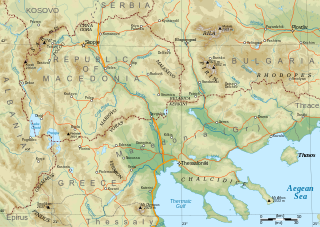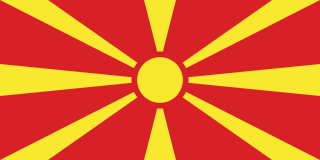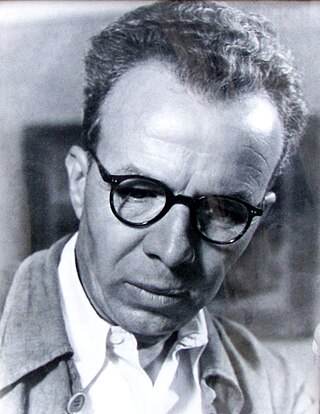Related Research Articles

Macedonia is a geographical and historical region of the Balkan Peninsula in Southeast Europe. Its boundaries have changed considerably over time; however, it came to be defined as the modern geographical region by the mid-19th century. Today the region is considered to include parts of six Balkan countries: all of North Macedonia, large parts of Greece and Bulgaria, and smaller parts of Albania, Serbia, and Kosovo. It covers approximately 67,000 square kilometres (25,869 sq mi) and has a population of around five million. Greek Macedonia comprises about half of Macedonia's area and population.
The history of North Macedonia encompasses the history of the territory of the modern state of North Macedonia.

North Macedonia is a country situated in southeastern Europe with geographic coordinates 41°50′N22°00′E, bordering Kosovo and Serbia to the north, Bulgaria to the east, Greece to the south and Albania to the west. The country is part of the wider region of Macedonia and makes up most of Vardar Macedonia. The country is a major transportation corridor from Western and Central Europe to Southern Europe and the Aegean Sea. North Macedonia is a landlocked country but has three major natural lakes: Lake Ohrid, Lake Prespa and Lake Dojran. It has a water area of 857 km2, while its land area is 24,856 km2.
The following is a summary of the transport system of the Republic of North Macedonia.

Skopje is the capital and largest city of North Macedonia. It is the country's political, cultural, economic, and academic centre. Skopje lies in the Skopje Basin.

The Vardar Banovina, or Vardar Banate, was a province (banate) of the Kingdom of Yugoslavia between 1929 and 1941.

Stobi or Stoboi, was an ancient town of Paeonia, later conquered by Macedon, and finally turned into the capital of the Roman province of Macedonia Salutaris. It is located near Gradsko, North Macedonia, on the main road that leads from the Danube to the Aegean Sea and is considered by many to be the most famous archaeological site in North Macedonia. Stobi was built where the Erigon joins the Axios (Vardar), making it strategically important as a center for both trade and warfare.

The history of the Jews in North Macedonia stretches back two thousand years, beginning during Roman antiquity, when Jews first arrived in the region. Today, following the Holocaust and emigration, especially to Israel, around 200 Jews remain in North Macedonia, mostly in the capital, Skopje and a few in Štip and Bitola.

The Serbs are one of the constitutional ethnic groups of North Macedonia, numbering about 24,000 inhabitants.

Vinča-Belo Brdo is an archaeological site in Vinča, a suburb of Belgrade, Serbia. The tell of Belo Brdo is almost entirely made up of the remains of human settlement, and was occupied several times from the Early Neolithic through to the Middle Ages. The most substantial archaeological deposits are from the Neolithic-Chalcolithic Vinča culture, of which Vinča-Belo Brdo is the type site.

Trebeništa is an ancient necropolis from the Iron Age southeast Illyria, near the northern shore of Lake Ohrid. The site is located near Trebeništa in modern-day North Macedonia. It is believed that the necropolis was used by the people from the nearby Illyrian town of Lychnidos. They are considered to have been the product of the local Illyrian population, which were attested in later historical sources and Hellenistic epigraphic material to have been the Dassaretii, also identified with the earlier Enchelei, who constituted the oldest known Illyrian kingdom. Some have hypothecised a Thracian influence, or a mixed Balkano-Aegean cultural expression. Archaeological material with gold-riches from the burials at Trebeništa, Aiani on the middle valley of the Haliacmon, and Sindos on the Thermaic Gulf, indicates substantial cultural continuity throughout the wider region, despite the fact that different tribes lived in the various areas of the whole region.

Tourism in North Macedonia is a large factor of the nation's economy. The country's large abundance of natural and cultural attractions make it suitable for tourism.

The groups of people who have settled or controlled the territory of modern-day North Macedonia have influenced the country in many ways, one of the most visible being architecture. These groups of people include the Paionians, Illyrians, Ancient Macedonians, Romans, Byzantines, Bulgarians, Serbs, Ottomans, Yugoslavs, and ethnic Macedonians.

North Macedonia, officially the Republic of North Macedonia, is a landlocked country in Southeast Europe. It shares land borders with Greece to the south, Albania to the west, Bulgaria to the east, Kosovo to the northwest and Serbia to the north. It constitutes approximately the northern third of the larger geographical region of Macedonia. Skopje, the capital and largest city, is home to a quarter of the country's population of 1.83 million. The majority of the residents are ethnic Macedonians, a South Slavic people. Albanians form a significant minority at around 25%, followed by Turks, Roma, Serbs, Bosniaks, Aromanians and a few other minorities.

Gragjanski Skopje was a football club from Skoplje, Yugoslavia. The club's major achievements were the two participations in the Royal League during the period of 1923 till 1940, and playing in the Bulgarian Championship between 1941 and 1944. Between 1941 and 1947 it was called FC Makedonia..
The history of Skopje, North Macedonia, goes back to at least 4000; remains of Neolithic settlements have been found within the old Kale Fortress that overlooks the modern city centre. The settlement appears to have been founded around then by the Paionians, a people that inhabited the region. It became the capital of Dardania, which extended from Naissus to Bylazora in the second century BC. Roman expansion east brought Scupi under Roman rule on the eve of the 1st century AD. When the Roman Empire was divided into eastern and western halves in 395 AD, Scupi came under Byzantine rule from Constantinople. During much of the early medieval period, the town was contested between the Byzantines and the Bulgarian Empire. It served as Bulgarian capital from 972 to 992. After 1018, it was a capital of Byzantine theme of Bulgaria after the fall the First Bulgarian Empire. In 1189 the town was part of the Serbian realm later becoming the capital of the Serbian Empire. In 1392 the city was conquered by the Ottoman Turks and they named the town Üsküb. The town stayed under Ottoman rule for over 500 years. During that period it was famous for its oriental architecture.

Miloje Vasić was a Serbian archaeologist, regarded as one of the most distinguished representatives of the humanistic studies in Serbia.

The Ohrid line was a narrow gauge railway line in what is now the Republic of North Macedonia. It ran to a gauge of 600 mm.
Borka Dragojević-Josifovska, in Serbian: Борка Драгојевић-Јосифовска was a Bosnian archaeologist, museum curator, numismatist and philologist, who was Professor of Classical Philology at Ss. Cyril and Methodius University of Skopje, and who worked mainly on classical archaeology in North Macedonia.

Emanuel Hristov Čučkov also known as Mane Čučkov was a Macedonian statesman, partisan, author and professor.
References
- 1 2 3 Ludomir R Lozny, ed. (2011). Comparative Archaeologies: A Sociological View of the Science of the Past. Springer New York. pp. 417–427. ISBN 9781441982254.
- ↑ Blaže Ristovski, ed. (2009). Macedonian Encyclopedia (in Macedonian). Macedonian Academy of Sciences and Arts. p. 90.
- ↑ Loring Danforth (1995). The Macedonian Conflict Ethnic Nationalism in a Transnational World. Princenton University Press. p. 169. ISBN 9780691043579.
- ↑ "Macedonia: Valuable Artifacts Found". Balkan Insight. 20 July 2009.
- ↑ "Presented findings from Rasnica archaeological site in Ohrid-Struga region". MIA. 8 November 2024.